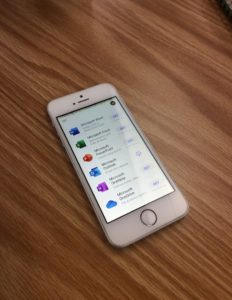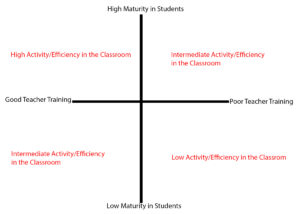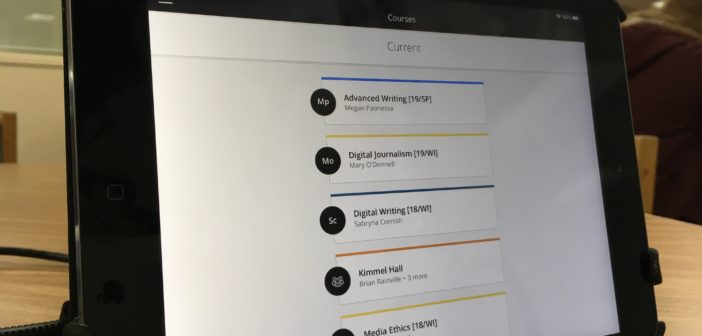Education has made great strides in the way that technology has been increasingly integrated into teachers’ curriculum. This could be done as a method to get a student’s attention because of the level of interaction that occurs when they are following along on a lecture presented by their teacher.
Then there is the other side of the story where students may find themselves being distracted by the technology that was thought to be helpful toward our students. While technology is ideal for obtaining the attention of our students, there is no guarantee that they will see it the same way. It is very tempting for some to go off course, even for a short time, to check in on the latest trends on Twitter, Instagram or the score of a game going on at the same time as a lecture.
The debate among teachers among elementary, high school and college level has been centered around the question of whether technology belongs in the classroom and to what extent should its presence be included. Should technology be incorporated during each class period or more sporadically to focus more on the traditional form of teaching? The question that also arises is whether those teaching in schools should have more freedom to decide rather than adhering to what the district requires?
Walden University reports a large percentage of professors seeing greater access to online resources. The benefits include increased engagement, collaboration and connection, incorporation of different learning styles and probably the most important, preparing children for the future. Some research even goes as far as saying that banning technology can ostracize those with learning disabilities.
There was an instance, also reported in TES, where mobile phones were banned within an entire boarding school. The decision made by Dorothy MacGinty, headteacher of Kilgraston School in Perthshire, Scotland, was one that she had anticipated would be met with negative reactions. She was correct in making this assumption, at least initially. After some time had passed, MacGinty was told about the mostly positive effects of her mobile phone ban.
“It has had an instantaneous effect in school. One can feel a palpable sense of relief among the girls, as if a storm has passed over their heads and life is returned to normal. Soft, bubbly chatter everywhere. Girls are more present and more relaxed, and more responsive” one teacher said. Dorothy had made the ban in an attempt “to get on with the core task of teaching and learning.”
While she had succeeded from a social aspect, her policy only forced a ban on mobile phones, which students mainly use for social networking, messaging and taking pictures. It would make sense for these devices only to be banned from school since they are more likely to be a distraction for students. In addition to being educators, teachers play a role in helping students develop as young adults. It is easy for social media to plague a student’s mind into not believing they are good enough due to the comparisons made to their peers that they see online. A mobile phone ban might be beneficial, but not technology as a whole.
Brenda Ruiz, a teacher assistant at Algonquin Middle School, has first-hand experience with teaching students from 6th to 8th grade. Her concern centers mainly around the maturity of students in middle school. While she says technology is good for students, they simply are not ready at this age.
Although being considered a more traditional approach, some teachers might be against having their students having access to the internet freely whether it be through school-issued laptops or their own personal smartphones or tablets. There is some validity in having a certain wariness towards the free use of technology, yet is it realistic to issue a restriction or even ban on technology?
The world that we live in is increasingly becoming dependent on technology, especially in the workplace. Some might even say it is a necessity in the classroom. To deny them access to technology would go against the ethos of educators. For students who study graphic design like Lorena Aguilar, the use of technology in the classroom is vital for projects both in and outside of class. She describes the use of technology to be both “powerful and impactful” as Smartboards and tablets provide the opportunity to go beyond the traditional classroom lecture.
Bruce Spitzer, department chair of education at North Central College thinks of a grid when it comes to the role of technology in the classroom. On one axis, there are teachers who want no technology because it is a distraction. On the other end of the spectrum, some teachers absolutely need technology. The other axis consists of students who need technology because of its resources. The other end being students who are aware of technology’s capability to distract away from a lecture.
“As a technology-using teacher, I want students to have a device with them all the time. I don’t want to have to send an email to my class and say ‘hey bring a device to class because we’re going to use it’. I want them to have it there all the time,” said Spitzer.
However, the type of device actually makes a difference. “Yes, PowerPoint is available on your phone and yes you can create a PowerPoint slideshow on your phone, but you’re working on a screen that’s only this big. That’s not a true-to-life picture of the application and you don’t have the full power of the application right there in front of you.”

For Spitzer, mobile applications on smartphones don’t have the same capabilities as they do on a laptop or computer
Engagement is at the heart of successful technology use in the classroom. “I also challenge faculty members who struggle with what to do with technology or students getting distracted by technology. You have to create an engaging class. You have to engage them with technology in pedagogically appropriate ways so that they’re using the technology for your class and they don’t have time to go out and visit Facebook and Instagram,” said Spitzer.
The increased implementation of technology has the potential to teach crucial skills for students at all levels.
“Along with maturity, I think truly comes good critical thinking skills that students need to be able to look at something online and determine the value of what they’re seeing…we need to develop those critical thinking skills because anybody can put anything online,” said Spitzer.

The level of maturity and teacher training can produce different levels of efficiency for students
Suzanne Chod, professor of political science, sees the benefits of being able to have an increased level of engagement thanks to technology in her classroom, namely social media. “I think (technology) not only helps engage with the material and for every type of learner to be able to be their best type of student but it also helps me as an instructor it helps kind of ‘spice things up’ during a two hour lecture period,” said Chod.
“Twitter is a primary social media tool that I use in class. Students are required to tweet outside of class time about things that are happening in the world that relate to our course content and then I can bring those connotations back into the classroom,” said Chod.
While social media being used for class purposes could be seen as innovative, Chod notices it has its limitations with her students. In 2019, Twitter might not be considered the hot new platform it once was. Yet, Chod finds overall that her students do end up finding it useful.
“When I do get comments about it, they’re typically positive and there’s pretty significant, strong research that shows that this is a useful tool for students to engage with the world,” said Chod.
As an aspiring teacher studying secondary education and English, Kennedy Taylor weighs in on in the increasing use of technology in the classroom that her and her future students will utilize.
“It’s a huge part of the current teacher training program…whether it be through the curriculum, extracurricular activities, or administering assessments.” Taylor also acknowledges students’ prior knowledge of technology and how it is better to utilize it rather than regress to an old-fashioned method of teaching. “Any potential harm can be combated if you’re a well-trained teacher.”
When asked about the potential harm of a ban on mobile technology, Taylor placed an importance on teachers and administration keeping rules strict and holding everyone accountable while upholding rules.
“Anytime you have a zero-tolerance policy of any kind, it becomes difficult because students are going to push against it no matter what.” In her student-teaching experience, safety was a concern when mobile phones were banned at all times. Social media was often the cause of altercations between students happening, yet phones were not confiscated. “It’s so much easier to incorporate phones in your classroom if you know most of your students have them.” As a student, Taylor praises technology as being crucial to her learning essential skills that she would use later on in college and later in life.
Cherokee Imel, an elementary education major, has spent a great deal of time student-teaching fifth-graders at a nearby elementary school. She describes how technology has already been implemented during the times that she had taken over classes, mostly through the form of PowerPoint presentations for her students to follow along with. She describes a moment where her students think of an innovative way to utilize their access to technology.
This proved to be overall beneficial for every student in the classroom for those who felt more comfortable using technology but also taught them how to use helpful applications and overall get excited about learning.

